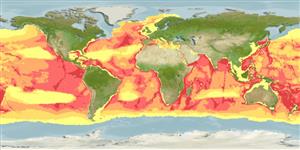Common names from other countries
Environment: milieu / climate zone / depth range / distribution range
Ecologie
Pelagisch; oceanodroom (Ref. 75906); diepteverspreiding 0 - 2332 m (Ref. 116169). Tropical; 90°N - 90°S, 180°W - 180°E
Atlantic Ocean, Mediterranean and Indo-Pacific. Tropical to warm temperate.
Length at first maturity / Size / Gewicht / Leeftijd
Maturity: Lm ?, range 366 - 427 cm Max length : 600 cm TL mannelijk/geslacht niet bekend; (Ref. 1394); 500 cm TL (female); Maximaal gepubliceerd gewicht: 2.0 t (Ref. 1394)
Found in shallow inshore (Ref. 122680) and deep offshore waters (Refs. 1394, 118705). Typically in groups of 10 to 60 individuals (Ref. 801). Food sharing is observed in this species, and they travel in a broad band up to several kilometers wide in order to increase success of finding prey (Ref. 122680). Feeds primarily on fish like mahi mahi and yellowfin tuna (Ref. 122680) and cephalopods (Refs. 801, 1394, 118705); was reported to attack small cetaceans and, on one occasion, even a humpback whale (Ref. 1394).
Breeding occurs throughout the year (Ref. 97351).
Tan, J.M.L. 1995. (Ref. 936)
Status op de Rode Lijst van het IUCN (Ref. 130435)
Status bij CITES (Ref. 108899)
Not Evaluated
Gebruik door de mens
Visserij: commercieel
FAO - Visserij: landings, soortsprofiel | FishSource | Sea Around Us
Tools
Internet-bronnen
Estimates based on models
Preferred temperature
(Ref.
115969): 2.3 - 5.8, mean 3.4 (based on 3246 cells).
Kwetsbaarheid
Very high vulnerability (85 of 100).
Prijsklasse
Unknown.
